A Two-Parameter Model for Water-Lubricated Pipeline Transportation of Unconventional Crudes
Abstract
1. Introduction
- (1)
- core annular flow (CAF);
- (2)
- self-lubricated flow (SLF); and
- (3)
- water-assisted flow (WAF).
- single-fluid models;
- and two-fluid models.
2. Materials and Methods
2.1. Experimental Data
2.2. Modeling Approach
2.2.1. Phenomenological Analysis
- separation of the oil-rich core from the pipe wall by a thin water annulus;
- high viscosity and, therefore, negligible shear in the core;
- laminar or plug flow condition of the core;
- turbulent water annulus subjected to high shear;
- sporadic contacts between the wavy oil core and the pipe wall, thus forming a durable oil film on the pipe wall known as wall-fouling;
- entrapment of the turbulent water annulus between the stationary wall-fouling layer and the high-speed oil core; and
- turbulent water annulus resulting in an unusual roughness on the wall-fouling layer that further intensifies the shear in the annulus.
2.2.2. Data Regression
3. Results
3.1. Regression Output
3.2. Model Output
4. Discussion
4.1. Performance of Existing Models
4.1.1. Arney et al.’s Model
4.1.2. Joseph et al.’s Model
4.1.3. Rodriguez et al.’s Model
4.1.4. McKibben et al.’s Model
4.1.5. Shi et al.’s Model
4.2. Classification of the Existing Models
4.2.1. Non-WAF Models
4.2.2. Water-Assisted Flow Models
4.3. Performance of the Current Model
4.4. Statistical Analysis
4.4.1. Coefficient of Determination
4.4.2. Root Mean Square Error
4.4.3. Average Absolute Relative Deviation
5. Conclusions
- (1)
- Two separate sets of pressure gradient data were collected from the literature. Stainless steel and PVC pipelines were used to generate the data. The experimental pipe sizes varied within a broad range of 25 mm to 265 mm. The oil viscosity and the water fraction were also changed over wide ranges of 1.22–26.5 Pa.s and 0.1–0.79, respectively.
- (2)
- The proposed model could be implemented for the SS and PVC datasets. It provided satisfactory predictions for both datasets, which proves its robustness and adaptability. The model estimates were within ±25% of the experimental measurements.
- (3)
- The R2 was significantly higher, while the RMSE and the AARD were considerably lower for the current model compared to other models.
Author Contributions
Funding
Institutional Review Board Statement
Informed Consent Statement
Data Availability Statement
Acknowledgments
Conflicts of Interest
Symbols and Notations
| Pressure gradient or frictional pressure loss (kPa/m) | |
| f | Fanning friction factor for water lubricated flow (-) |
| Density of Arney et al. model specific hypothetical fluid (kg/m3) | |
| V | Average velocity (m/s) |
| U | Superficial velocity (m/s) |
| Uo | Oil superficial velocity (m/s) |
| Uw | Water superficial velocity (m/s) |
| D | Internal diameter of the pipe (m) |
| Re | Reynolds number (-) |
| Rea | Arney et al. model specific equivalent Reynolds number (-) |
| Rew | Water equivalent Reynolds number (-) |
| Water viscosity (mPa·s) | |
| Hw | Water hold-up (-) |
| Ho | Oil hold-up (-) |
| ρw | Water density (kg/m3) |
| ρo | Oil density (kg/m3) |
| Cw | Input water fraction (-) |
| s | Slip ratio (-) |
| n | Constant (-) |
| b | Constant (-) |
| k | Constant (-) |
| Fr | Froud number (-) |
| LPF | Lubricated pipe flow |
| CAF | Core annular flow |
| SLF | Self-lubricated flow |
| WAF | Water assisted flow |
| SRC | Saskatchewan Research Council |
| CU | Cranfield University |
| ID | Internal diameter |
| SS | Stainless steel |
| PVC | Polyvinyl chloride |
| R2 | Coefficient of Determination |
| RMSE | Root-mean-square error |
| AARD | Average absolute relative deviation |
References
- Arney, M.S.; Bai, R.; Guevara, E.; Joseph, D.D.; Liu, K. Friction factor and holdup studies for lubricated pipelining-I. Experiments and correlations. Int. J. Multiph. Flow 1993, 19, 1061–1076. [Google Scholar] [CrossRef]
- Hart, A. A review of technologies for transporting heavy crude oil and bitumen via pipelines. J. Pet. Explor. Prod. Technol. 2014, 4, 327–336. [Google Scholar] [CrossRef]
- McKibben, M.; Sanders, S.; Gillies, R. A new method for predicting friction losses and solids deposition during the water-assisted pipeline transport of heavy oils and co-produced sand. In Proceedings of the SPE Heavy Oil Conference-Canada, Calgary, AB, Canada, 11–13 June 2013. [Google Scholar] [CrossRef]
- Ho, W.S.; Li, N.N. Core-annular flow of liquid membrane emulsion. AIChE J. 1994, 40, 1961–1968. [Google Scholar] [CrossRef]
- Rodriguez, O.M.H.; Bannwart, A.C.; de Carvalho, C.H.M. Pressure loss in core-annular flow: Modeling, experimental investigation and full-scale experiments. J. Pet. Sci. Eng. 2009, 65, 67–75. [Google Scholar] [CrossRef]
- Rushd, M.M.A.S. A New Approach to Model Friction Losses in the Water-Assisted Pipeline Transportation of Heavy Oil and Bitumen. Ph.D. Thesis, University of Alberta, Edmonton, AB, Canada, 2016. [Google Scholar] [CrossRef]
- Russell, T.W.F.; Charles, M.E. The effect of the less viscous liquid in the laminar flow of two immiscible liquids. Can. J. Chem. Eng. 1959, 37, 18–24. [Google Scholar] [CrossRef]
- Rushd, S.; McKibben, M.; Sanders, R.S. A new approach to model friction losses in the water-assisted pipeline transportation of heavy oil and bitumen. Can. J. Chem. Eng. 2019, 97, 2347–2358. [Google Scholar] [CrossRef]
- Rushd, S.; Sultan, R.A.; Mahmud, S. Modeling Friction Losses in the Water-Assisted Pipeline Transportation of Heavy Oil. In Processing of Heavy Crude Oils: Challenges and Opportunities; Gounder, R.M., Ed.; IntechOpen: London, UK, 2019. [Google Scholar] [CrossRef]
- Joseph, D.D.; Bai, R.; Mata, C.; Sury, K.; Grant, C. Self-lubricated transport of bitumen froth. J. Fluid Mech. 1999, 386, 127–148. [Google Scholar] [CrossRef][Green Version]
- Oliemans, R.V.A.; Ooms, G. Core-Annular Flow of Oil and Water through a Pipeline. In Multiphase Science and Technology; Hewitt, G.F., Delhaye, J.M., Zuber, N., Eds.; Springer: Berlin/Heidelberg, Germany, 1986. [Google Scholar] [CrossRef]
- Crivelaro, K.C.; Damacena, Y.T.; Andrade, T.H.; Lima, A.G.; Farias Neto, S.R. Numerical simulation of heavy oil flows in pipes using the core-annular flow technique. WIT Trans. Eng. Sci. 2009, 63, 193–203. [Google Scholar] [CrossRef]
- de Andrade, T.H.F.; Crivelaro, K.C.O.; de Farias Neto, S.R.; de Lima, A.G.B. Numerical Study of Heavy Oil Flow on Horizontal Pipe Lubricated by Water. In Materials with Complex Behaviour II; Öchsner, A., da Silva, L., Altenbach, H., Eds.; Springer: Berlin/Heidelberg, Germany, 2012. [Google Scholar] [CrossRef]
- Kaushik, V.V.; Ghosh, S.; Das, G.; Das, P.K. CFD simulation of core annular flow through sudden contraction and expansion. J. Petrol. Sci. Eng. 2012, 86, 153–164. [Google Scholar] [CrossRef]
- Shi, J.; Gourma, M.; Yeung, H. CFD simulation of horizontal oil-water flow with matched density and medium viscosity ratio in different flow regimes. J. Petrol. Sci. Eng. 2017, 151, 373–383. [Google Scholar] [CrossRef]
- Shi, J.; Lao, L.; Yeung, H. Water-lubricated transport of high-viscosity oil in horizontal pipes: The water holdup and pressure gradient. Int. J. Multiph. Flow 2017, 96, 70–85. [Google Scholar] [CrossRef]
- Shi, J. A study on High-Viscosity Oil-Water Two-Phase Flow in Horizontal Pipes. Ph.D. Thesis, Cranfield University, Cranfield, UK, 2015. [Google Scholar]
- Rushd, S.; Sanders, R.S. A parametric study of the hydrodynamic roughness produced by a wall coating layer of heavy oil. Pet. Sci. 2017, 14, 155–166. [Google Scholar] [CrossRef] [PubMed]
- McKibben, M.J.; Gillies, R.G.; Shook, C.A. Predicting pressure gradients in heavy oil-water pipelines. Can. J. Chem. Eng. 2000, 78, 752–756. [Google Scholar] [CrossRef]
- Branch, M.A.; Coleman, T.F.; Li, Y. Subspace, interior, and conjugate gradient method for large-scale bound-constrained minimization problems. SIAM J. Sci. Comput. 1999, 21, 1–23. [Google Scholar] [CrossRef]
- Bannwart, A.C. Modeling aspects of oil–water core–annular flows. J. Pet. Sci. Eng. 2001, 32, 127–143. [Google Scholar] [CrossRef]
- Halali, M.A.; Azari, V.; Arabloo, M.; Mohammadi, A.H.; Bahadori, A. Application of a radial basis function neural network to estimate pressure gradient in water–oil pipelines. J. Taiwan Inst. Chem. Eng. 2016, 58, 189–202. [Google Scholar] [CrossRef]
- Rudolf, J.F.; William, J.W.; Ping, S. Regression Analysis: Statistical Modeling of a Response Variable, 2nd ed.; Elsevier: Amsterdam, The Netherlands, 2006; p. 459. [Google Scholar]
- Chai, T.; Draxler, R.R. Root mean square error (RMSE) or mean absolute error (MAE)?-Arguments against avoiding RMSE in the literature. Geosci. Model Dev. 2014, 7, 1247–1250. [Google Scholar] [CrossRef]
- Blaikie, C.N. Descriptive Analysis—Univariate Looking for Characteristics. In Analyzing Quantitative Data from Description to Explanation; Sage Publications: London, UK, 2003; pp. 47–88. [Google Scholar] [CrossRef]
- Alizadehdakhel, A.; Rahimi, M.; Sanjari, J.; Alsairafi, A.A. CFD and artificial neural network modeling of two-phase flow pressure drop. Int. Commun. Heat Mass Transf. 2009, 36, 850–856. [Google Scholar] [CrossRef]
- Zabihi, R.; Mowla, D.; Karami, H.R. Artificial intelligence approach to predict drag reduction in crude oil pipelines. J. Pet. Sci. Eng. 2019, 178, 586–593. [Google Scholar] [CrossRef]
- Boostani, M.; Karimi, H.; Azizi, S. Heat transfer to oil-water flow in horizontal and inclined pipes: Experimental investigation and ANN modeling. Int. J. Therm. Sci. 2017, 111, 340–350. [Google Scholar] [CrossRef]
- Meeker, W.Q.; Hahn, G.J.; Escobar, L.A. Statistical Intervals: A Guide for Practitioners and Researchers; John Wiley & Sons: Hoboken, NJ, USA, 2017; pp. 23–36. [Google Scholar]
- Bewick, V.; Cheek, L.; Ball, J. Statistics review 7: Correlation and Regression. Crit. Care 2003, 7, 451–459. [Google Scholar] [CrossRef] [PubMed]
- Brahimi, T. Using Artificial Intelligence to Predict Wind Speed for Energy Application in Saudi Arabia. Energies 2019, 12, 4669. [Google Scholar] [CrossRef]

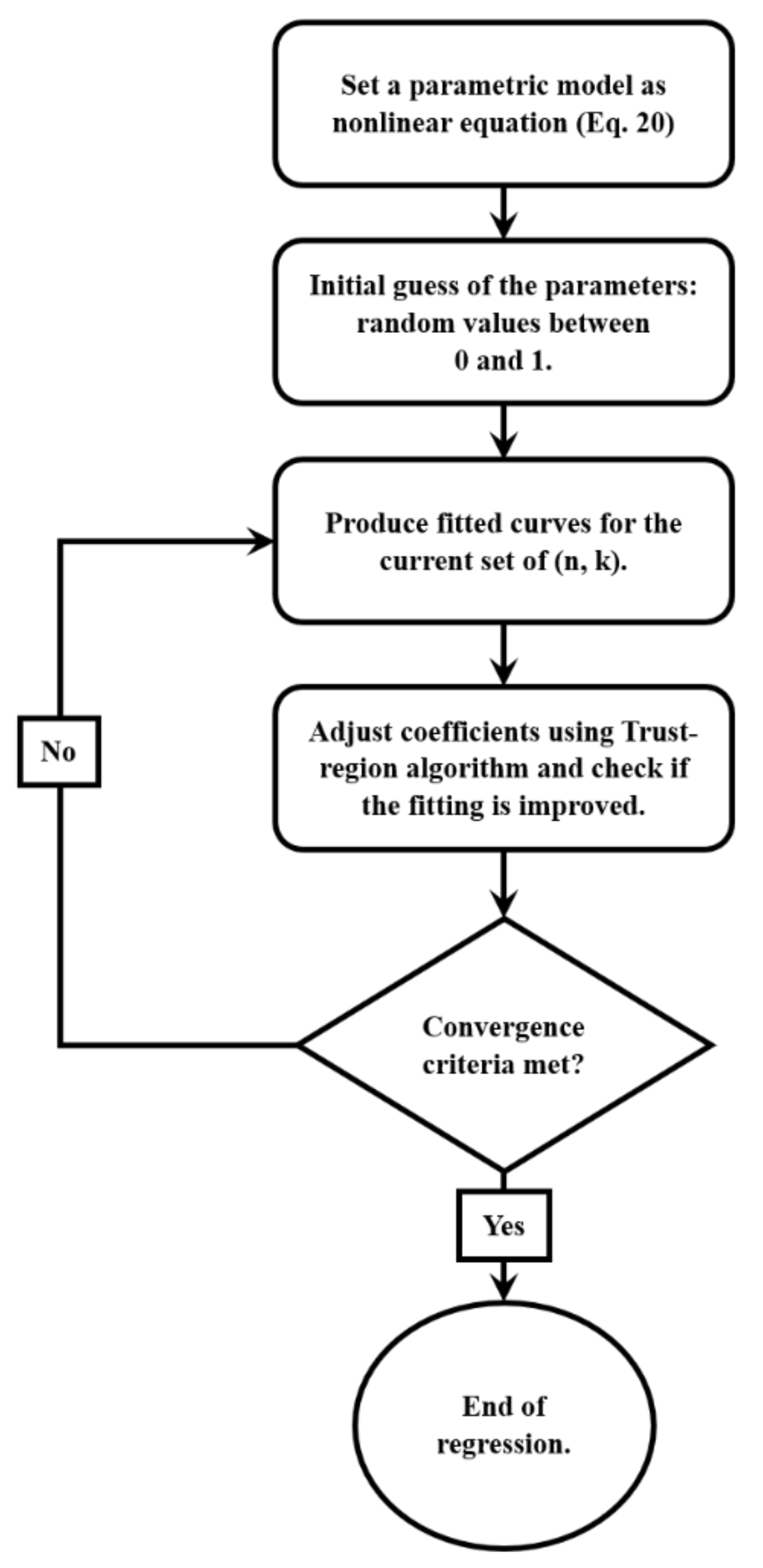

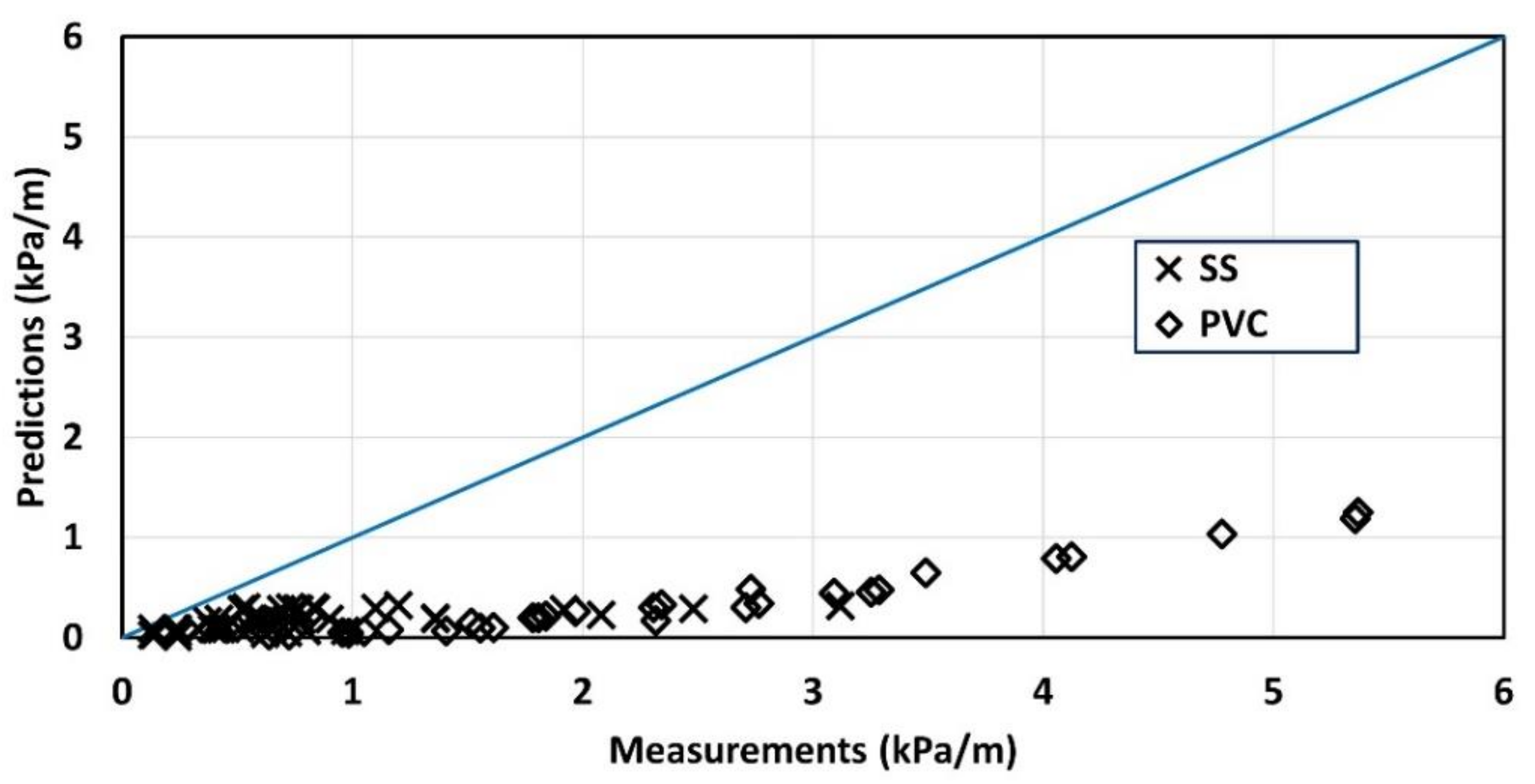

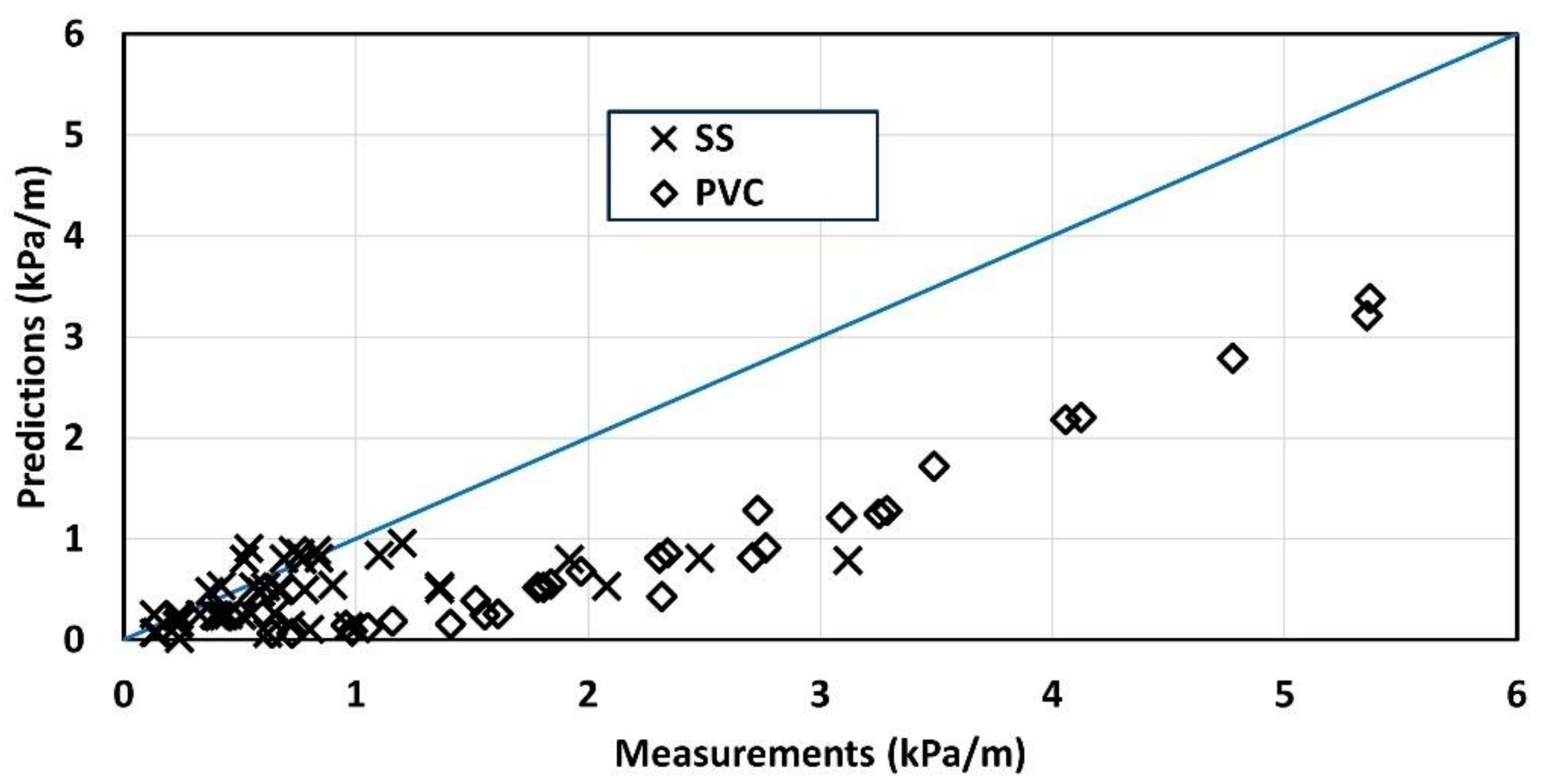

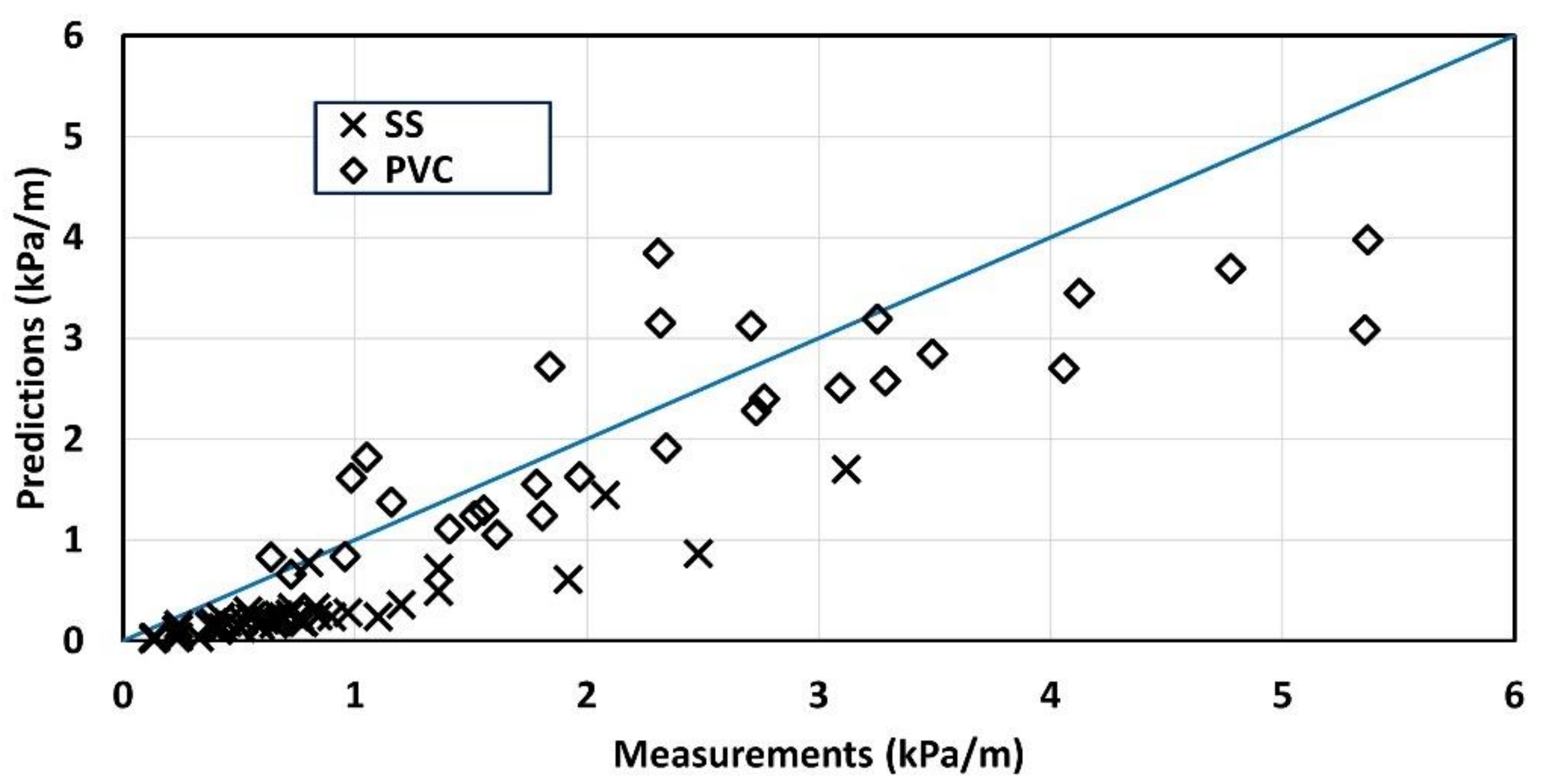
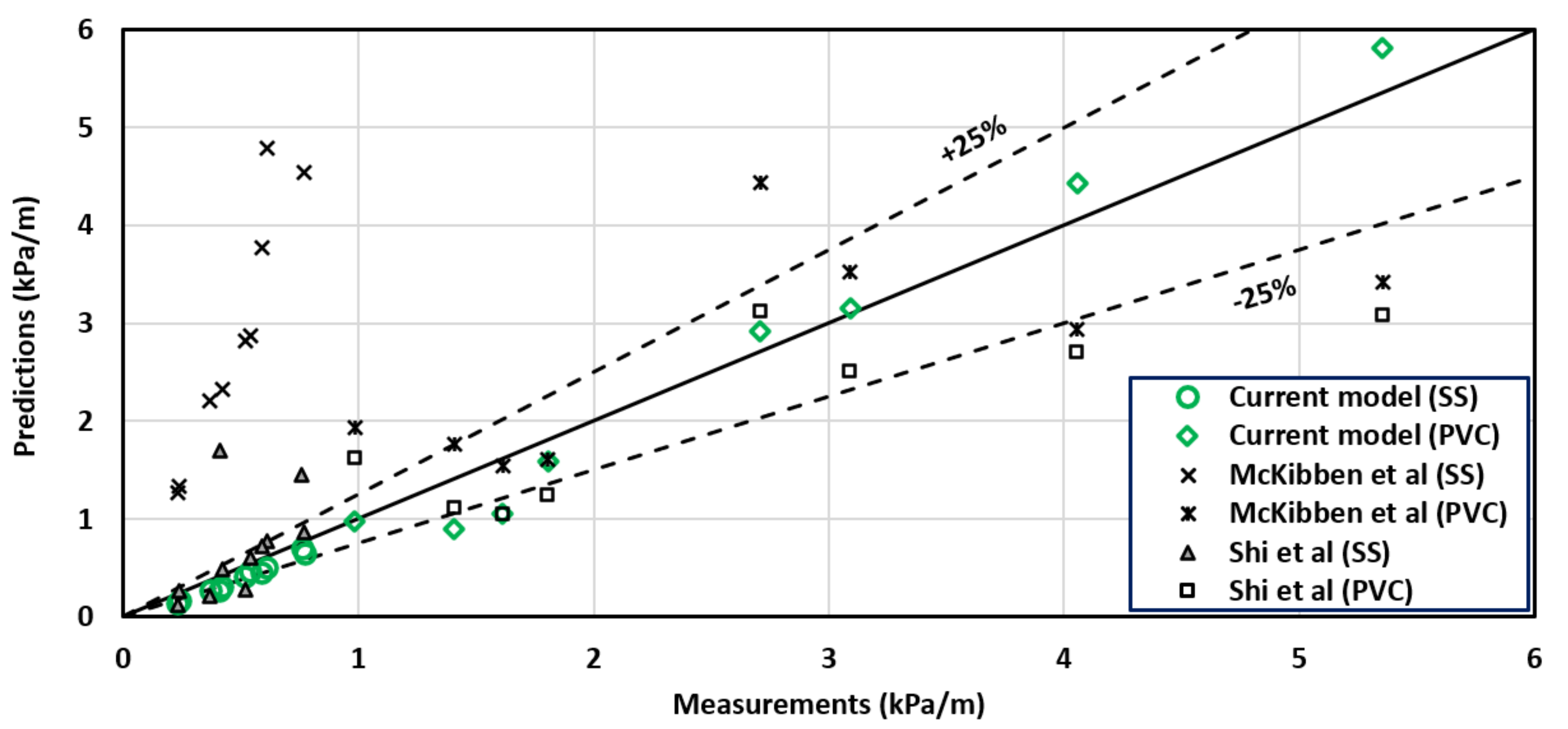
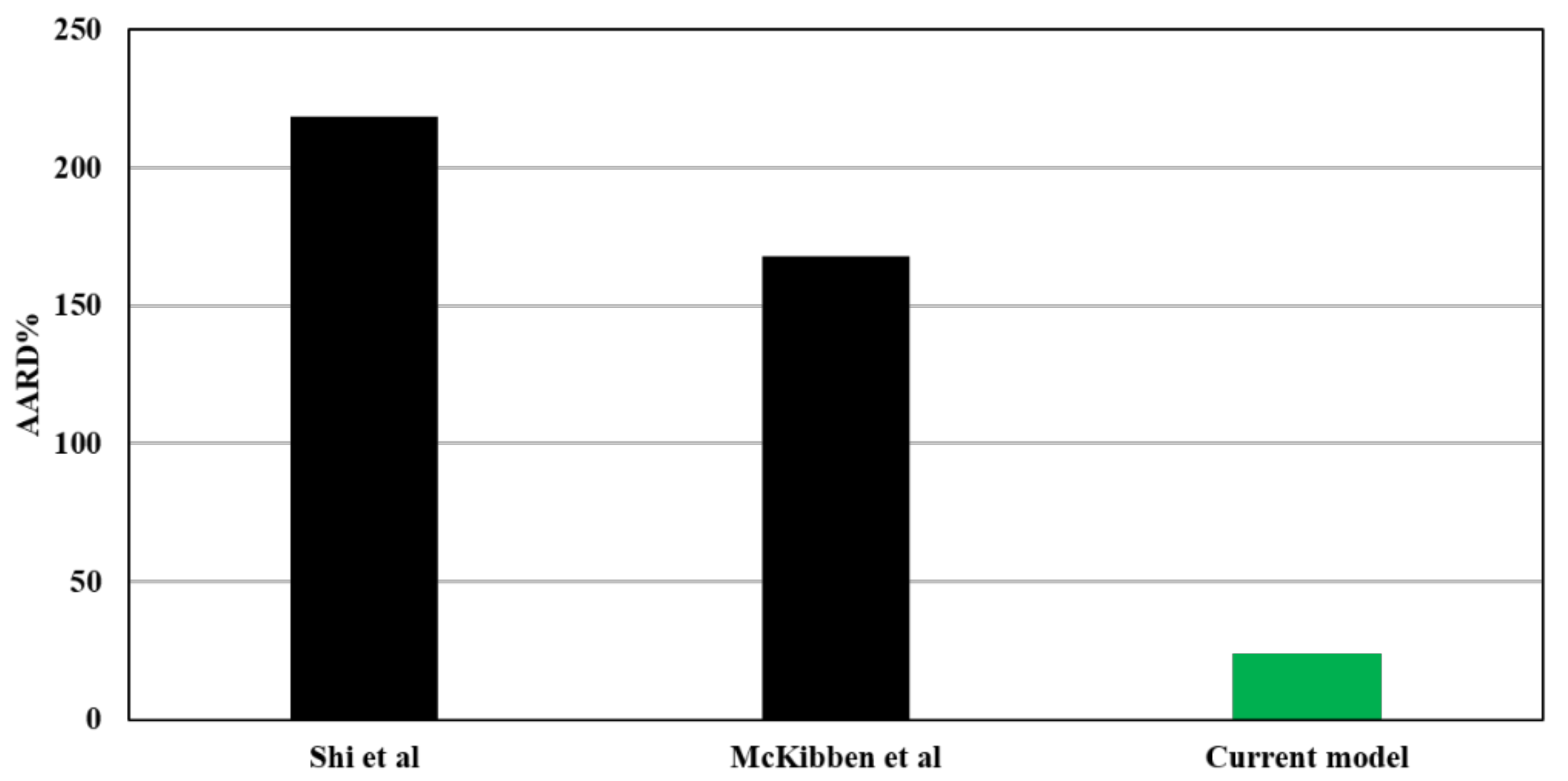
| Data Source | Pipe Construction Material | Pipe Diameter (mm) | Average Velocity (m/s) | Oil Viscosity (mPa·s) | Water Viscosity (mPa·s) | Water Fraction (-) |
|---|---|---|---|---|---|---|
| [6] | SS | 103.3 264.8 | 1.0 1.5 2.0 | 1220 1300 1400 16,600 26,500 | 0.67 0.72 0.89 | 0.17–0.43 |
| [17] | PVC | 26 | 0.19–1.728 | 3300 5600 | 1.27 1.00 | 0.30–0.79 |
| Pipe Construction Material | Subset | Number of Data Points (%) | Pipe Diameter (mm) | Average Velocity (m/s) | Oil Viscosity (mPa·s) | Water Fraction (-) |
|---|---|---|---|---|---|---|
| SS | Modeling | 36 (77%) | 103.3 264.8 | 1.0 1.5 2.0 | 1300 1400 26,500 | 0.17–0.43 |
| Test | 11 (23%) | 103.3 | 1.0 1.5 2.0 | 1220 16,600 | 0.24–0.42 | |
| PVC | Modeling | 21 (72%) | 26 | 0.188–1.719 | 5600 | 0.24–0.79 |
| Test | 8 (28%) | 26 | 0.264–1.728 | 3300 | 0.19–0.68 |
| Models | R2 | RMSE |
|---|---|---|
| McKibben et al. | 0.15 | 2.21 |
| Shi et al. | −0.11 | 0.80 |
| Current model | 0.85 | 0.45 |
Publisher’s Note: MDPI stays neutral with regard to jurisdictional claims in published maps and institutional affiliations. |
© 2021 by the authors. Licensee MDPI, Basel, Switzerland. This article is an open access article distributed under the terms and conditions of the Creative Commons Attribution (CC BY) license (https://creativecommons.org/licenses/by/4.0/).
Share and Cite
Rushd, S.; Ahmed, E.; Mahmud, S.; Hossain, S.S. A Two-Parameter Model for Water-Lubricated Pipeline Transportation of Unconventional Crudes. Energies 2021, 14, 5665. https://doi.org/10.3390/en14185665
Rushd S, Ahmed E, Mahmud S, Hossain SS. A Two-Parameter Model for Water-Lubricated Pipeline Transportation of Unconventional Crudes. Energies. 2021; 14(18):5665. https://doi.org/10.3390/en14185665
Chicago/Turabian StyleRushd, Sayeed, Ezz Ahmed, Shahriar Mahmud, and SK Safdar Hossain. 2021. "A Two-Parameter Model for Water-Lubricated Pipeline Transportation of Unconventional Crudes" Energies 14, no. 18: 5665. https://doi.org/10.3390/en14185665
APA StyleRushd, S., Ahmed, E., Mahmud, S., & Hossain, S. S. (2021). A Two-Parameter Model for Water-Lubricated Pipeline Transportation of Unconventional Crudes. Energies, 14(18), 5665. https://doi.org/10.3390/en14185665








